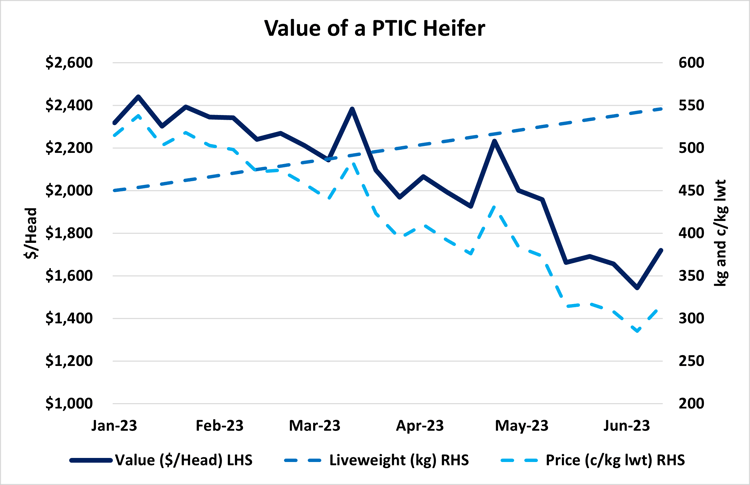For the first six months of 2023, there have been repeated reports of cattle producers holding breeding stock on farm for longer than planned. This is predominantly due to the idea that ‘I don’t like the prices on offer, and I’ve got plenty of feed still, I will add more weight to them and hopefully prices will improve.’ While seasonal conditions and pasture availability have broadly held up well, prices have consistently declined over that time. While the adage that ‘weight beats rate’ usually holds true, prices have declined beyond what weight gain can counteract.
Key Points:
PTIC heifer prices have declined by 46% in five months
The estimated weight gain of a PTIC heifers over that period has not counteracted falling prices
Vendors should assess their breakeven point before choosing to sell or hold
Average prices for PTIC heifers have declined 46% in the last five months as restocker demand has diminished. From $2,695/head on 6 January 2023 to $1,456/head on 16 June (it has been one of the fastest falls in recent history).
To understand our ‘weight beats rate’ assessment, we need to break that down into a per kilogram of liveweight basis. On that basis, prices have fallen 39% from 515c to 315c/kg lwt.
For our analysis, we will take a heifer of 450kg starting weight in January 2023 and will assume a weight gain of 600g per day*. By June it will be 546kg liveweight. The question is, has that weight gain helped to offset the decline in prices over the first half of 2023.
That 450kg PTIC heifer was worth $2,318/head in January, and if it sold on June 16, it would be worth $1,720/head. The weight of that PTIC heifer has increased by 21%, however prices have decreased 39%, leading to a 26% decline in value (Figure 1).
 Figure 1: Modelled value of a PTIC Heifer Jan 2023 – Jun 2023
Figure 1: Modelled value of a PTIC Heifer Jan 2023 – Jun 2023
There’s no doubt the last six months have been tough in terms of market decline. The question that seems to be on the mind of many producers is whether we have hit a bottom in the market, and if holding stock will be the best option to ride out this negative territory.
It is important for producers to do the maths when it comes to considering whether to sell or hold onto livestock. That will depend on your individual circumstances, such as if you have an abundance of feed, etc.
The adage of ‘weight beats rate’ works to a point. Producers should calculate what that breakeven point is based on expected weight gain and price movement before making a decision.
The AuctionsPlus Insights team will look to model this scenario in a future MarketPulse, using steers as an example. Look out for that analysis.
For any suggestions, feel free to email me at dthomson@auctionsplus.com.au
*This weight gain will vary depending on breed, location, feed quality etc. However, 600g has been used for this exercise following consultation with several cattle breeders
Lorem Ipsum is simply dummy text of the printing and typesetting industry. Lorem Ipsum has been the industry's standard dummy text ever since the 1500s
Subscribe to our weekly newsletter and monthly cattle, sheep, and machinery round-ups.